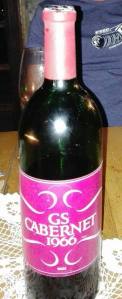Over the weekend I had the opportunity to open a GS with good friends at the historic Bizansgat in the Ceres Karoo. The bottle has good provenance as it came from descendants of George Spies himself. It had a good ullage just below the neck and close to top shoulder and the cork, although darkend, came out in one piece.
The wine had an incredible deep color and not light as one would expect of older wine. On the nose there was something that reminded me of sherbet and something else.. almost dare I say chemical (or synthetic?).
In the mouth it was dense, concentrated and incredibly fresh for such an old wine. There was lots of fruit, velvet and fine tannins and very new-world like. All was in balance and complete.
Interestingly the table was somewhat divided on the “greatness” of the wine. One taster was in awe while another was not convinced.
I thought it incredible but not so much for how it tasted (although it does taste great), but the fact that it was completely intact and fresh almost to the point of a modern era SA red. Also because it is so very different to any other old South African wine I ever tasted.
My thoughts keep returning to the wine because I am puzzled by it. I am puzzled because it is so different, so intact and years ahead of its time. We might never know what exactly George Spies did in the cellar in 1966, but it certainly was a resounding success!
Hennie Taljaard
22 Aug 2016
A couple of wine critics wrote about the GS, but I thought Tim James provided an accurate description of the wine in 2013:
I’ve had various experiences with the GS cabs (only two vintages made, remember: 1966 and 1968) – some excellent bottles, some poor ones. That weary bit of wisdom about there being no great wines, just great bottles applies most relevantly to older wines, of course. This one was served blind. The light was fancy-restaurant-poor, but the wine was fairly deep-coloured, with no very great signs of ageing. I’m sure better light would have given me a better clue, but I guessed mid 1990s, and my first guess at origin was California. It was rich, fresh, full of flavour, and still hinting at primary fruit. I reckon the most youthful bottle of this wine I’ve had, though Chris said the level was right down into the shoulder. I might have suspected a bit of cheating – but the cork was certainly authentic: tiny, black and shrunken.
Also read: “The mystery of South Africa’s greatest red”: the-mystery-of-south-africas-greatest-red

The GS is also lingering in my mind. It’s truly a facinating and mysterious wine that demands further inquiry or understanding.
The other wines from that era we tasted alongside the GS (and many other examples from the 70’s 80’s) was much more recipe-type wines where generally the same kind of procedure was taken with each vintage and only the amount of acidity that was added differed acording to the vintage conditions.
The freshness or preservation of the wines basically came down to its’s (added) acidity where probably the tannin structures played a lesser role. Many of these wine’s acidities could still stand slightly apart from the wines and is a dead giveaway of the winemaking procedures. The structures of these wines are often less expressed or have disintegrated after many years wich give them a lightness or even easy/ smooth palates with very little weight. The GS was the opposite.
Because it’s generally known that it was an experimental wine more made in a technical way, maybe different or new methods were used that was not possible in a conventional cellar at the time.
Some claimed it was 100% de-stemmed and fermented in stainless steel and never matured in oak barrels. It’s also pondered that it never went through malo-lactic fermentation and sterile filtered before bottling which may explain the well integrated acidity and freshness. The structure and density of the wine was the most striking attribute. Velvety, silky, almost the talcum type softness, but very definite mid palate weight and prominent structure. Where this comes from is debatable, it might be extended skin maceration, or even longer lees contact, but if the idea was that the wine was made as clinical as possible, it is unlikely. It must’ve been super clean, and protected all the way. Sulphur could have been applied quite liberally and a sterile filtration probably also could’ve helped with the incredible preservation of this wine.
Unfortunately, because it is so rare , (and expensive) most judgings would be based on one bottle at a time. One can also not throw-out the bottle variation factor (its been 50 years!). This particular bottle did not over-impress in the aromatic department, but the intact-ness and the youth of it was astonishing. It lets you wonder if this wine can go all the way, for another 50 years perhaps!?!
Any further concrete information about the grapes, wine making process would be really interesting and could shed more clarity on this legendary wine.
I am not an expert on the subject of old wines and dont often get the oppertunity to drink them, but it is probably one of the the most interesting fields of wine appreciation. Heritage, history, mystery, it has it all!
Fantastic experience, thanks Hennie for this oppertunity.
LikeLiked by 1 person
Thanks Jasper for the comment – very insightful and lots to reflect on!
LikeLike